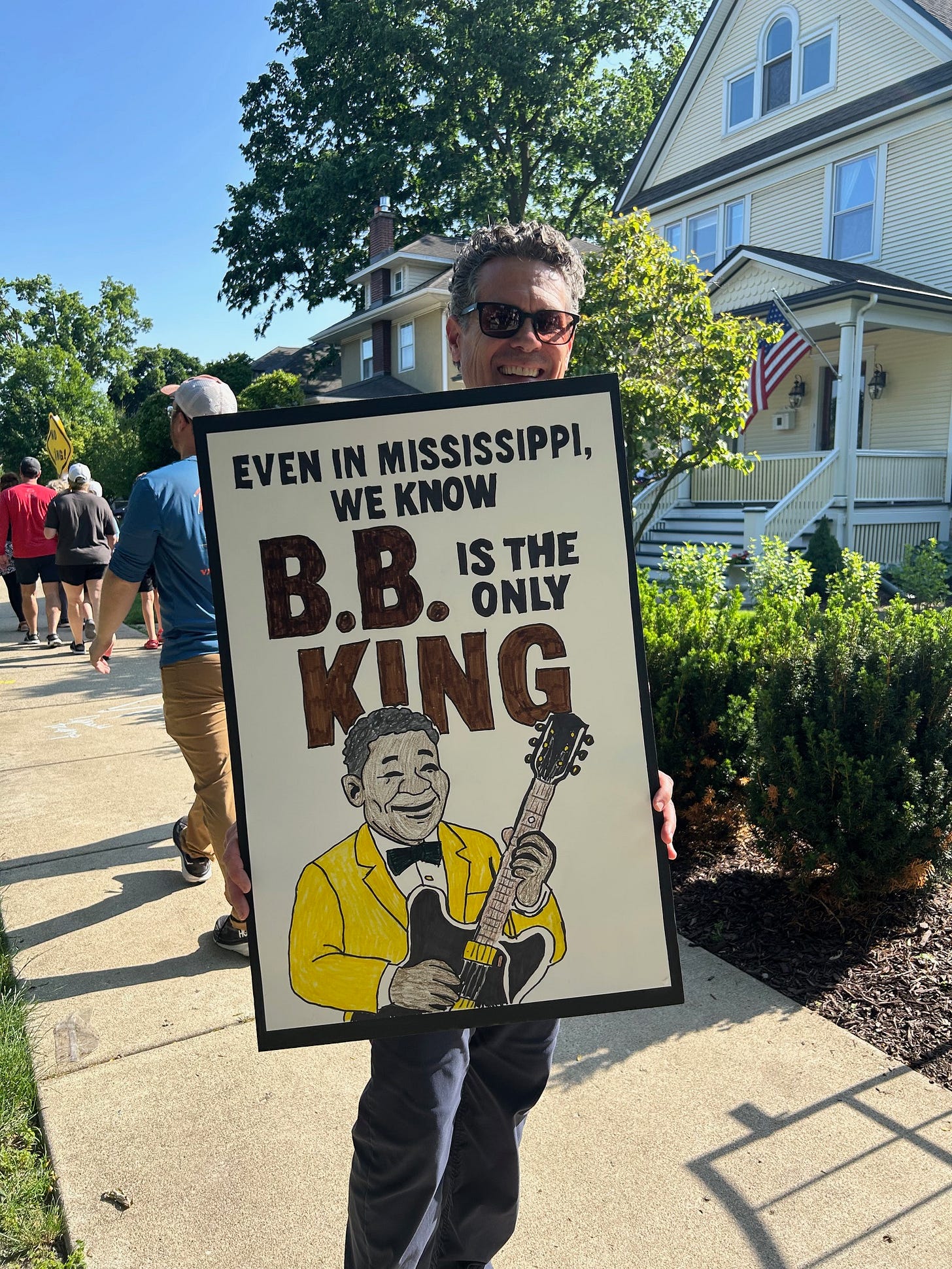“People have just gotten angrier and angrier, and for some, this is a hateful era of public speech and political violence. But for others, it’s the time to start gathering again as communities, in person—to meet again, and resist.
“At some point, you’ve got to look in the mirror when you look at what’s going on here. Every single elected official does.” — Sen. Amy Klobuchar, D-Minnesota
LA GRANGE, Illinois— Walking down the main street of this popular and well-heeled Chicago suburb as a kid, I remember making a beeline most weekends to the local movie theater, an Egyptian Art Deco gem that would let kids in for a triple feature most Saturdays—three movies in succession for $10, literally mind-blowing (if you didn’t have to leave early).
This past Saturday, I visited that street again, but this time it was to watch another kind of show—a No Kings rally, one of the nearly 2,000 held across the nation to push back on what many now see as President Donald Trump’s widening authoritarianism, attacks on immigrants and civil rights, challenges to the rule of law and deep cuts to scores of federal programs.
Here, in this small community, there was no small crowd. Couples came, families came, individuals who said they’d never before protested came. An estimated 3,000 former and present neighbors, blue and some red, gathered for several hours, along with dozens of senior center residents and some local business owners. Most lined up along both sides of main street—three deep, parade-style, with their kids in tow—to wave hand-lettered signs and chant, “No Trump, No King” and “This is what democracy looks like” as cars passed, honking their horns in support.
The mood was both joyful and defiant. In front of the movie theater, neighbors—many wearing t-shirts reading “I am not a paid protester”—shared Sharpies and extra cardboard with those wishing to make some signs of their own.
The rally ended peacefully, yet some 400 miles north of here, in Minneapolis, the day was marred by news that political violence had occurred before dawn.
The details are now more clear. The man who shot and killed a Minnesota state representative and her husband early Saturday, in their home, was posing as a police officer. A short time earlier, he also forced his way into the home of another state legislator and his wife, and shot them 17 times. They survived.
The assassin had made a kill list of 45 people, all of them Democrats serving as state and local officials. Federal prosecutors say he was just leaving the second house he visited when discovered by police in a shoot-out. He then escaped on foot, later texting his wife and children on a group thread: “Dad went to war last night … I don’t wanna say more because I don’t wanna implicate anybody. …Words cannot express how sorry I am for this circumstance.”
The FBI found him the next day, covered with mud, hiding in a ditch of rural farmland some 50 miles outside Minneapolis. “Clearly, this was politically motivated,” U.S. Sen. Amy Klobuchar, D-Minnesota, told CNN.
The violence wasn’t a freak occurrence. Like school shootings, political violence is becoming routine, and rising.
Growing Threat
According to the Department of Homeland Security, politically motivated violence is among its top concerns for 2025.
Here’s why:
In a recent report, the United States Capitol Police said the number of “concerning statements” and direct threats made against members of Congress, alone, have nearly tripled since 2017.
The Anti-Defamation League says all of the 61 political killings in the United States between 2022 and 2024 were committed by right-wing extremists.
According to The New York Times, officials in at least three states are investigating or prosecuting people for making threats against politicians. In Texas, authorities said an armed man who had threatened to harm lawmakers at the State Capitol had been detained. In Georgia, a man was arraigned after prosecutors said he had threatened sexual violence against two United States senators. And in Virginia, a former Coast Guard officer was arrested and accused of making threats against President Trump online.
Right-wing political extremism—and President Trump’s combative rhetoric—is fueling many of the political attacks, says Reuters, Pew Research and a special report by The New York Times.
In a new report, the ADL reminds readers that in 2020, Gov. Gretchen Whitmer of Michigan, a Democrat, was the target of death threats and a kidnapping plot. In 2022, a right-wing dissident broke into the San Francisco home of Nancy Pelosi and bludgeoned her husband’s head with a hammer, an injury from which he is still recovering. And in April, the home of Pennsylvania Gov. Josh Shapiro, a Democrat, was set on fire on the first night of Passover as he and his family slept inside.
“This is a hateful era of public speech,” says journalist Susan Glasser, a writer for The New Yorker. “First, there’s this terrible threat of physical violence against elected officials. But there’s also the demonization of them and of public figures of any type, including journalists and their family members. …This is one of those moments when you hope that people sit up, at attention, and say that things have really gone quite too far in this country.”
Blistering Rhetoric
Later in the day Saturday, Trump joined in the official bipartisan condemnation of the Minnesota shootings, calling them “horrific violence.” But Trump—himself the survivor of two relatively recent attempts on his life—has a long record of calling his political opponents “sick” and “evil” publicly, and making statements condoning and encouraging violence. [At a campaign event on October 31 of last year, Trump called former U.S. Representative Liz Cheney “a radical war hawk” and told attendees, “Let’s put her with a rifle standing there, with nine barrels shooting at her, okay? Let’s see how she feels about it, you know, when the guns are trained on her face.”]
During another campaign event last year, Trump called the people put in jail for what they did during the January 6th, 2021 attack on the U.S. Capitol “unbelievable patriots”—and called people who disagree with him “very bad people” and “sick” and “radical left lunatics” who should “really be easily handled, if necessary, by the national guard—or if really necessary, by the military.” At that same event, he told MAGA supporters: “I am your warrior, I am your justice, and for those of you who have been wronged and betrayed, I am your retribution.”
Is there a fading line between violent political rhetoric and politically-triggered physical violence?
Gunmen who killed 11 worshippers at a synagogue in Pittsburgh in 2018, 23 shoppers at a heavily Latino Walmart in El Paso in 2019 and 10 Black people at a Buffalo grocery store in 2022 each cited the political conspiracy theory that a secret cabal of Jews are trying to replace white people with people of color. That theory is held by many members of the far right who have been supporting Trump’s push to limit immigration.
“We’ve entered into this especially scary time in the country where it feels the sort of norms and rhetoric and rules that used to come out of the White House to tamp down on violence has been lifted,” says Matt Dallek, a political scientist at Georgetown University who studies extremism. “A lot of people are receiving new signals from the political culture.”
Adds Julian Zelizer, a professor of political history at Princeton University: “What really stands out to me now is that the biggest source of chaos is the President, himself, not the left. Trump, rather than acting as a force to try to bring some kind of reconciliation, calm and stability to the nation in these times of political division, he is fueling the fires.”
Split Screen
Higher levels of political polarization also have created a stark, split-screen view of America at home and abroad. Trump’s multi-million dollar military parade in Washington to celebrate the U.S. Army’s 250 years of military force [and Trump’s 79th birthday] was occurring at the same time an estimated 6 million people were gathering in peaceful No King protests across the country to oppose, among other things, Trump’s domestic use of military force and his claim that the U.S. Constitution gives him “the right to do whatever I want.”
“We have a President who ran on America First, willing to send hundreds of U.S. Marines to Los Angeles to quell protests of his policies, and then exhibit a show of military force in a parade, threatening before it started, that anyone protesting the parade would be ‘met by a very big force’,” Glasser says. “Is he redefining, in some ways, the concept of national security to mean beating domestic enemies, the immigrants and the ‘left-wing lunatics’ he calls ‘the enemies from within?’”
Adds Dallek: “It now sometimes feels like the extremists are in the saddle, and the extremists are the ones now trying to drive our rhetoric and politics.”
Maybe so. But judging by the authentically deep and rising public opposition to Trump, his divisive rhetoric and his challenges to the rule of law, the struggle over the future of America won’t be won without a fight.
What do you think? Is there a fading line between rhetorical extremism and political violence? Let us hear your thoughts.
NOTE: This post was updated on June 18 and again on June 19 to include new poll numbers, additional examples of violent political rhetoric and extremism, an expanded reference to the No Kings rallies being held Saturday across the nation, and updated information about the Minneapolis shootings.






